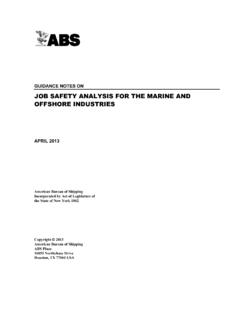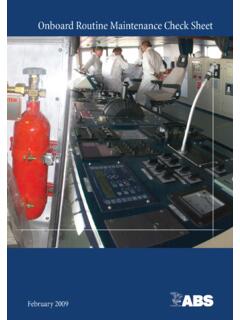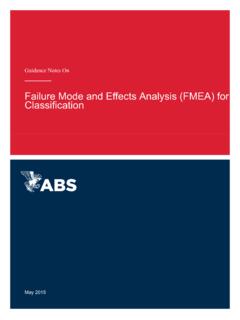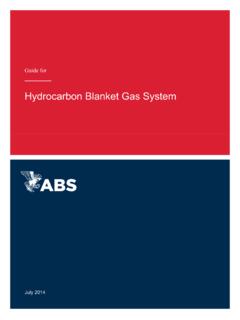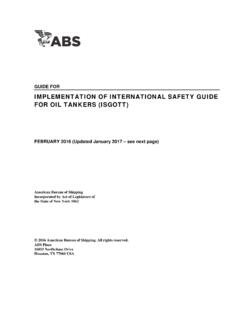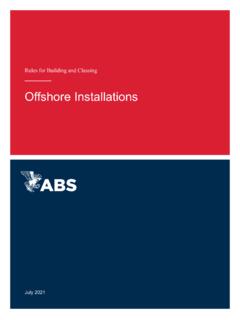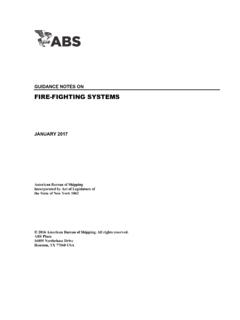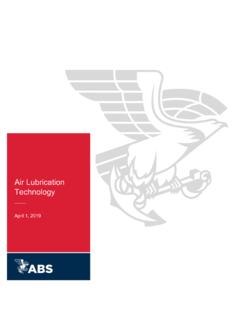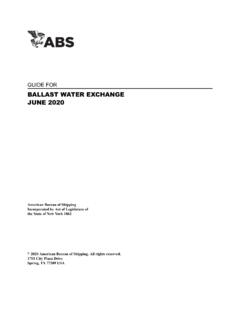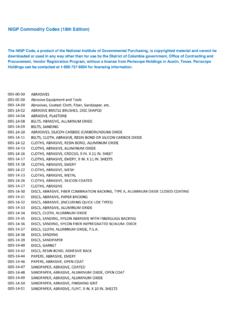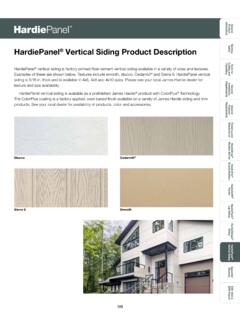Transcription of Guidance Notes on the Application and Inspection of Marine …
1 Guidance Notes on the Application and Inspection of Marine coating Systems Guidance Notes ON THE Application AND Inspection OF Marine coating SYSTEMS JANUARY 2017 American Bureau of Shipping Incorporated by Act of Legislature of the State of New York 1862 2016 American Bureau of Shipping. All rights reserved. ABS Plaza 16855 Northchase Drive Houston, TX 77060 USA Foreword Foreword (1 January 2017) The steel structure of a vessel is prone to corrosion th roughout its service life. Due allowance should be made at th e new building stage and by periodic maintenance to provide ef fective corrosion protection that contributes to the continued structural integrity of the vessel. Given the emphasis on protective coatings in the various mandated Rules and Regulations and the unprecedented acceleration of coating technology, personnel involved with coatings should have factual knowledge of coating systems and the applicable standards.
2 It is the intent of these Guidance Notes to meet this need in a straight-forwar d and practical manner. The Performance Standards for Protective Coatings (PSPC) from IMO are intended to standardize the requirements for protective coatings for ballast tanks, cargo oil tanks and void spaces for a target of 15 years of useful life. A good quality protective coating can delay the onset of corrosion of the structure. The mandated standards represent the latest in the line of many regulatory actions taken to enhance vessel longevity and thereby enhance safety. There has been an increased industry focus placed on the consequences of corrosion and an increased demand for better coating performance as primary corrosion control. This has led to adoption of ballast tanks PSPC for SOLAS Chapter II Part A-1 Regulation 3-2 on December 8, 2006, and adoption of PSPC for cargo oil tanks of all crude oil tankers per SOLAS Chapter II Part A-1 Regulation 3-11 on May 21, 2010.
3 Those mandated PSPC standards specify requirements for coating Application processes during various stages of new construction. To help industry to understand the major elements of PSPC requirements, ABS has produced and maintained this publication since 2007. As a direct response to the needs of industry personnel involved with the PSPC implementation, a complete revision has addressed the fundamentals of coating technology as applied to ship structures for the regulatory requirements for coatings in ballast tanks, void spaces, cargo tanks, cargo holds and outer hull anti-fouling systems. Figure 1 gives a brief timeline of requirements or recommendations from IMO and IACS. These Guidance Notes start with the basics of the chemistry, and mechanics of corrosion to understand protective coatings as a barrier to corrosion. The coating Application process technology and coating Inspection for surface preparation, environmental controls, film thickness measurements and the methods of coating Application are included.
4 Once a vessel is in-service, the coatings are subject to various conditions. To aid in the assessment of the coatings in service, coating assessment methods and typical failures are illustrated as Guidance . For ballast tank s PSPC of ABS classed vessels only, ABS provides the Guide for the Class Notation coating Performance Standard (CPS) and a detailed procedure to obtain the ABS CPS notation. ABS also provides the optional notations Environmental Protection (ENVIRO) or Environmental Protection Plus (ENVIRO+) for vessels and antifouling systems are as part of the ENVIRO or ENVIRO+ Notation requirement. Please note that the adoption of ballast water exchange practices (as per IMO Resolution (20)) may potentially have a negative effect on the longevity of the coatings. NACE has developed a test standard (NACE TM0112-2012) to determine the potential corrosion effects of Ballast Water Treatment Systems on Ballast Tanks. These Guidance Notes become effective on the first day of the month of publication.
5 Users are advised to check periodically on the ABS website to verify that this version of these Guidance Notes is the most current. We welcome your feedback. Comments or suggestions can be sent electronically by email to ii ABS Guidance Notes ON THE Application AND Inspection OF Marine coating SYSTEMS . 2017 FIGURE 1 Timeline of Development 1992199419961998200020022004200620082010 20122014 IACS UR Z9 ( 1992, last Rev. 1996), Corrosion Protection Coatings for Cargo Hold Spaces on Bulk Carriers. IMO Res. (18) (adopted on 4 November 1993), IACS to (1992/1992/1996/2001/2003, last 2009), Guidelines on ESP during surveys of bulk carriers and oil tankersIMO Res. (19) (adopted on 23 November 1995), coating guidelines for dedicated seawater ballast tanksSOLAS Ch II-1 (amended on 8 Dec. 2006), IACS PR34 (effective 8 Dec. 2006) for CSR BC/OT, PSPC (IMO MSC. Res. 215(82)) requirement on dedicated seawater ballast tanksSOLAS Ch II-1 (amended on 4 June 1996), IACS UI SC122, coating requirement on dedicated seawater ballast tanks.
6 Effective on 1 July 1998 IMO Res. A928(22) (adopted on 29 Nov 2001), AFS Control. Effective 17 September 2008 for flag signatory to AFS Convention. For EU, effective 1 January 2008. SOLAS Ch II-1 (amended on 8 Dec. 2006), IACS UI SC223/IMO , PSPC (IMO MSC. Res. 215(82)) requirement on dedicated seawater ballast tanks. Effective on 1 July 2008 SOLAS Ch II-1 (amended on 21 May 2010), PSPC (IMO MSC. Res. 288(87)) / CRS ((IMO MSC. Res. 289(87))) requirement on cargo oil tanks of crude oil tankers. Effective on 1 Jan. 2013 Note: See applicable regulations for details of the above dates ABS Guidance Notes ON THE Application AND Inspection OF Marine coating SYSTEMS . 2017 iii Table of Contents Guidance Notes ON THE Application AND Inspection OF Marine coating SYSTEMS CONTENTS SECTION 1 Corrosion .. 1 1 General .. 1 2 Uncoated Steel and the Corrosion Reaction .. 2 3 Factors Influencing Corrosion Rates .. 4 Oxygen .. 4 Temperature .. 4 Conductivity of Electrolytes.
7 4 Type of Ions .. 5 Acidity and Alkalinity (pH) .. 5 Electrochemical Potential .. 5 4 Types of Corrosion .. 5 Uniform Corrosion .. 5 Pitting Corrosion .. 6 Crevice Corrosion .. 7 Galvanic Corrosion .. 8 Deposition Corrosion .. 10 Impingement Corrosion .. 11 Microbiologically Influenced Corrosion (MIC) .. 11 FIGURE 1 Corrosion Cell .. 2 FIGURE 2 Anodic and Cathodic Areas Form on the Uncoated Steel Surface .. 3 FIGURE 3 Diffusion Pathways near Anodes and Cathodes .. 4 FIGURE 4 Pitting Corrosion on Uncoated Steel, Showing Layers of Iron Oxides .. 6 FIGURE 5 Different Pit Shapes .. 6 FIGURE 6 Crevice Corrosion .. 7 FIGURE 7 The Galvanic Series of Metals with the Most Noble Metals at the Bottom .. 9 FIGURE 8 Flow of Electrons in the Iron/Copper Couple .. 10 PHOTOGRAPH 1 Undercut Pits .. 7 PHOTOGRAPH 2 Pits Forming as a Result of Crevice Corrosion between the U Bolt Support and the Pipe .. 8 PHOTOGRAPH 3 Deposition Corrosion .. 10 PHOTOGRAPH 4 Impingement Corrosion.
8 11 iv ABS Guidance Notes ON THE Application AND Inspection OF Marine coating SYSTEMS . 2017 SECTION 2 Protective 13 1 General .. 13 2 Factors Affecting coating Lifetime .. 13 Oxygen Permeability .. 13 Water Vapor Permeability .. 13 Liquid Water Uptake .. 13 Ionic Permeability .. 13 coating Porosity .. 13 Surface Contamination .. 15 Surface Profile .. 15 3 Types of coating Breakdown .. 16 Blistering via Osmosis .. 16 Blistering via Electro Osmosis .. 16 Rust Jacking .. 17 Calcareous Deposit Jacking .. 17 4 Protective Coatings .. 18 Barrier Effect .. 18 Galvanic Effect .. 18 Inhibitor Effect .. 19 Surface Tolerant Coatings .. 19 5 coating Compatibility .. 19 FIGURE 1 Schematic coating Porosity in Single Coatings of Different thickness .. 14 FIGURE 2 Schematic coating Porosity in a Two Layer System .. 14 FIGURE 3 Schematic Showing the Need for Stripe Coatings .. 15 FIGURE 4 Schematic Osmotic Blister Formation .. 16 FIGURE 5 Schematic Electro Osmotic Blister Formation.
9 16 FIGURE 6 Rust Jacking .. 17 FIGURE 7 Calcareous Deposits .. 17 FIGURE 8 Complex Pathway Produced by Lamellar Pigments .. 18 FIGURE 9 Residual Contamination in Pits .. 19 SECTION 3 coating Types and Their Uses .. 20 1 General .. 20 2 Paint Composition .. 20 3 Binders .. 21 4 Cross-linked (Thermoset) Coatings .. 21 Epoxy Resins .. 21 Polyurethane Resins .. 21 Alkyd Resins .. 22 Inorganic Resins .. 22 5 Thermoplastic Coatings .. 22 Chlorinated Rubber Resins .. 22 Vinyl Resins .. 22 ABS Guidance Notes ON THE Application AND Inspection OF Marine coating SYSTEMS . 2017 v 6 Pigments and Extenders .. 23 Anti-corrosive Pigments .. 23 Barrier Pigments .. 23 Coloring Pigments .. 24 Extender Pigments .. 24 7 Solvents .. 24 True Solvent .. 24 Latent Solvent .. 24 Diluent Solvent .. 24 8 Anti-corrosion Paints .. 24 Pure Epoxy .. 25 Modified Epoxy .. 25 Coal Tar Epoxy .. 25 High Solid Content Epoxy .. 25 9 Impact and Abrasion-resistant Coatings.
10 26 10 Shop Primers .. 26 SECTION 4 Surface Preparation .. 27 1 General .. 27 2 Surface Cleanliness .. 28 3 Surface Cleaning .. 29 Solvent 31 Abrasive Dry Blasting .. 32 Hydro Blasting/Waterjetting .. 35 Power Tool Cleaning .. 36 Hand Tool Cleaning .. 37 Pickling .. 37 4 Preparation of Non-ferrous Metals .. 38 Galvanized steel with Zinc .. 38 Aluminum .. 38 Stainless Steel .. 38 5 Steel Work before Surface Preparation .. 39 Weld Preparation .. 39 Edge Preparation .. 41 FIGURE 1 Surface Profile .. 27 FIGURE 2 Schematic of Feathered Edges .. 33 FIGURE 3 Contamination Trapped in the Blast Profile is Over-coated .. 34 FIGURE 4 Schematic Fillet Weld Showing Typical Defects that Form Voids under the coating .. 41 FIGURE 5 Types of Edge Profile .. 41 PHOTOGRAPH 1 Salt Contamination Testing .. 28 PHOTOGRAPH 2 Outer Hull Showing Application of Primer after Localized Spot Blasting .. 29 PHOTOGRAPH 3 Oil and Grease Stains during Block Assembly Show as Dark Stains on the Shop Primer.
